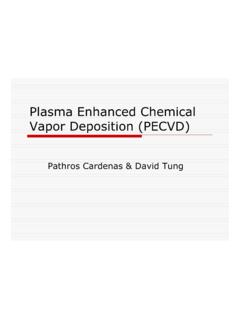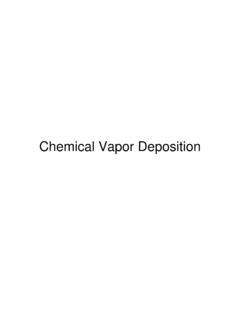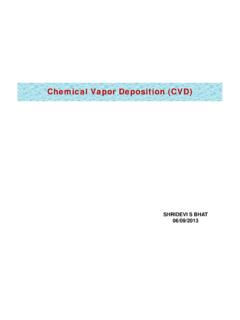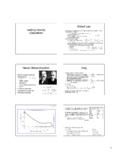Chemical vapor deposition
Found 9 free book(s)Lecture 12 Physical Vapor Deposition: Evaporation and ...
alan.ece.gatech.edumetal deposition can be used to deposit other materials as well. Several methods are currently used for deposition of metal layers. Physical Vapor Deposition techniques (PVD) 1.) Evaporation 2.) Sputtering 3.) Chemical Vapor Deposition (CVD) 4.) Electrochemical techniques 1.) Evaporation: Advantages: Highest purity (Good for Schottky
Chapter 1 Introduction to Chemical Vapor Deposition (CVD)
www.asminternational.orgIntroduction to Chemical Vapor Deposition (CVD) J. R. Creighton and P. Ho Sandia National Laboratories P.O. Box 5800, MS0601 Albuquerque, NM 87185-0601 Introduction Chemical vapor deposition (CVD) is a widely used materials-processing technology. The majority of its applications involve applying solid thin-film coatings to surfaces, but it is also
Plasma Enhanced Chemical Vapor Deposition (PECVD)
classweb.ece.umd.eduChemical Vapor Deposition for Microelectronics Principles, Technology, and Applications. Park Ridge, NJ: Noyes Publications, 1987. QUESTIONS? Title: Microsoft PowerPoint - PECVD Presentation.ppt Author: nganig Created Date: 10/24/2007 2:14:06 PM ...
Deposition - INRF
www.inrf.uci.eduThin dielectric films are deposited using plasma enhanced chemical vapor deposition (PECVD) or remote plasma chemical vapor deposition (RPCVD) of SiO2, Si3N4 or a-Si. The source gases for the PECVD SiO2 films are 5% SiH4 in N2 plus N2O; for SixNy films source gases include 5% SiH4 in N2 plus NH3 and N2.
Chemical Vapor Deposition - users.wfu.edu
users.wfu.eduChemical Vapor Deposition (CVD) • Deposition can also take place due to a chemical reaction between some reactants on the substrate. • In this case reactant gases (precursors) are pumped in to a reaction chamber (reactor). • Under the right conditions (T, P), they undergo a reaction
Chemical Vapor Deposition (CVD)
tue.iitm.ac.inChemical vapour deposition may be defined as the deposition of a solid on a heated surface from a chemical reaction in the vapour phase. It belongs to the class of vapour-transfer processes which is atomistic in nature, that is the deposition species are atoms or molecules or a combination of these. Schematic of a simple thermal CVD reactor
Chemical Vapor Deposition
home.iitk.ac.in• Chemical vapor deposition (CVD) is the most important process in microfabrication. • It is used extensively for producing thin films by depositing many different kind of foreign materials over the surface of silicon substrates, or over other thin films that have already been deposited to the silicon substrate.
Chemical Vapor Deposition (cont.)
users.wfu.eduChemical Vapor Deposition (cont.) CVD Reactor Notes • The kinetics of your reaction mostly determines the choice of the reactor type. • Mass transport limited growth (high T): – Should be able to control gas flow and pressure to get uniform films • …
Stokes' Law Settling Velocity (Deposition)
aerosols.ucsd.edu(Deposition) Stokes' Law • the drag on a spherical particle in a fluid is described by Stokes' Law for the following conditions: – fluid is a Newtonian incompressible fluid du k /dx k =0 – gravity is negligible g=0 – flow is creeping flow, i.e. Re<<1 du k /dx k =0 – steady-state flow du j /dt=0 • Navier-Stokes Equation








